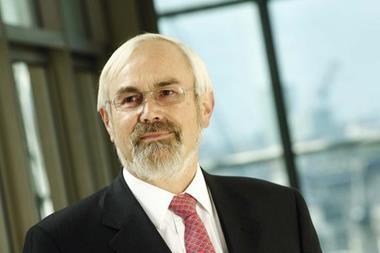Behind the mild-mannered exterior of the Lloyd’s finance director is a will of steel. We talk to the man determined to whip the Solvency II directive into a shape that best serves the market
If ever there was a man who does not suit his moniker, it is Lloyd’s finance director Luke Savage. Despite being responsible for the finances, risk management and operations of the world’s oldest – and arguably most complex – insurance market, he is calm, mild-mannered and softly spoken. Even questions about rumoured lapses in Lloyd’s underwriters’ pricing discipline are met with a measured response.
Mention Savage’s pet subject of Solvency II, however, and the gloves are off. Along with Lloyd’s general counsel Sean McGovern, Savage is responsible for the Lloyd’s response to Solvency II, and he is determined to ensure that neither Lloyd’s itself nor the industry is hindered by the European Commission’s upcoming directive.
“There is a real risk, if Solvency II isn’t implemented properly and Ceiops [the Committee of European Insurance and Occupational Pensions Supervisors] gets its way, that many of the original objectives behind Solvency II will not be achieved,” he warns.
Under the new regime, insurers will be able to use the directive’s standard capital adequacy model or apply to use their own internal model as the basis for solvency capital requirements. However, Savage is concerned that the current status of the standard model could counter the directive’s original goals.
“Given the direction Ceiops has been taking … there is a real risk that a lot of insurers will have to put up a lot more capital and spend vast amounts of money implementing Solvency II,” he says. “Because of the problems with the standard formula, there is a risk you won’t have capital best aligned with risks. You won’t end up with a more competitive market – you will end up with higher capital and higher costs. In which case, two of the main purposes of Solvency II are immediately lost.”
Powers of persuasion
A particular concern for Savage is regulators’ reaction to the global financial crisis. “We saw quite a clear change,” he says. “After the banking crisis started to hit, the European insurance regulators suddenly became far more cautious in their approach to Solvency II – to a point where it started to lose credibility.”
There is cause for optimism, however. Recent lobbying efforts from Lloyd’s succeeded in reversing a decision by Ceiops that could have harmed a number of companies writing internationally. Savage says that the financial crisis prompted the committee to propose removing credits for geographic diversification from the fifth Solvency II quantitative impact study, known as QIS5.
“We came up with our own methodology and persuaded the FSA and the Comité Européen des Assurances to support it, and the EU has put it back into the latest QIS5 proposals,” Savage says. “That is a huge win for us and for every global insurer within Europe.”
It is not surprising that Lloyd’s is throwing so much weight behind Solvency II. Lloyd’s, unlike the other firms that Solvency II will regulate, is not a single entity but a marketplace in which
51 individual insurance businesses operate. Some of these are subsidiaries of large international insurance groups, while others are small, standalone firms. Because of its unique structure, laws drafted for the industry generally do not tend to suit Lloyd’s and it often has to have provisions or exemptions officially drafted for it.
To manage the diversity, Savage says, Lloyd’s sets standards for its members to achieve but does not mandate how they achieve them. He acknowledges, however, that Solvency II is a bigger challenge for the smaller operators within the market. “Smaller players at Lloyd’s still have to achieve standards similar to those that a big, sophisticated player would be expected to achieve, but they don’t have the resources to do it,” he says.
Therefore, the market is doing work centrally to ease the burden for its smaller members. “Rather than each individual business having to try to analyse what the impact was to them and provide feedback, we were able to co-ordinate that centrally and do it on behalf of the market,” Savage says.
In addition to being a filter, Lloyd’s has also acted as a guide. “It is not just telling people what they have to do, but giving them ideas on how to achieve it,” Savage explains.
Maintaining discipline
Solvency II is only one of many challenges facing Lloyd’s. Given the general softening of prices in the global (re)insurance markets, maintaining underwriting discipline among its members is a big focus for the corporation. Having suffered heavily at the hands of sloppy underwriters in the not-too-distant past – the most memorable example being the London market excess-of-loss spiral, which nearly brought the market to its knees in the early 1990s – Lloyd’s now takes the matter very seriously. It appointed its first franchise performance director, Rolf Tolle, in 2002. The role was assumed by former Berkshire Hathaway executive Tom Bolt in September 2009 following Tolle’s retirement.
Despite Tolle and his successor’s rigour, rumours persist that Lloyd’s underwriters are too quick to lower prices to win business. Savage, however, dismisses this as sour grapes from the losers. “We are a competitive marketplace and you would expect our members to compete on price,” he asserts. “It is not surprising that when someone loses business to one of their peers, they are going to start complaining.”
If there is a lack of discipline, he argues, it is easy to catch and correct at Lloyd’s. “If it’s happening we get to hear about it, because of the amount of gossip there is around the market – and we will go and tap people on the shoulder,” he says.
‘Never been stronger’
One might also assume that a big concern for the finance director of Lloyd’s would be the losses the market has made to date in 2010. Lloyd’s estimates that its net claims from the earthquake in Chile will be $1.4bn (£908m), and is expecting a further $300m-$600m from the Deepwater Horizon oil rig disaster. With a good three months of the US hurricane season still remaining, anything could happen in the remainder of the year.
However, Savage is relaxed about this too. “We are in the business of providing people cover against earthquakes and hurricanes, and if this is a year we pay out, it is a year we pay out.”
But he adds: “In terms of our ability to meet claims, be they earthquakes, oil rig losses or windstorms coming down the line, Lloyd’s has never been stronger. Our premium trust funds, funds at Lloyd’s and the central fund are all at record levels. We will be able to meet whatever comes down the path to us.”
The figures speak for themselves. As of 31 March, central assets for solvency purposes at Lloyd’s stood at £2.84bn. This is on top of syndicate-level assets and members’ funds, which stood at £37.4bn and £13.2bn respectively as of 31 December last year. That should be enough to calm even the most jittery of finance directors. IT






































No comments yet